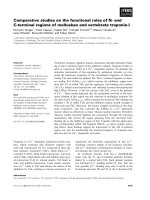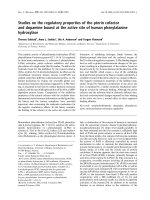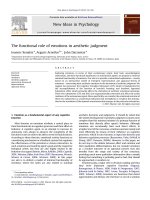Studies on the cytoprotective role of autophagy in necrosis
Bạn đang xem bản rút gọn của tài liệu. Xem và tải ngay bản đầy đủ của tài liệu tại đây (4.51 MB, 229 trang )
STUDIES ON THE CYTOPROTECTIVE ROLE OF
AUTOPHAGY IN NECROSIS
WU YOUTONG
(M. Med, Huazhong Univ Sci & Tech, P. R. CHINA)
A THESIS SUBMITTED
FOR THE DEGREE OF DOCTOR OF PHILOSOPHY
DEPARTMENT OF EPIDEMIOLOGY
AND PUBLIC HEALTH
NATIONAL UNIVERSITY OF SINGAPORE
2010
II
ACKNOWLEDGEMENTS
I would like to dedicate my sincere and deep gratitude to my supervisor,
Associate Professor Shen Han-Ming, for his enthusiastic professional guidance. Prof.
Shen has led me into the vast world of biological research and has guided me with
inspirations during the tough, yet exciting, journey throughout this study. Besides
acting as a mentor, Prof. Shen has also treated me like a friend, sharing with me of his
invaluable experience in life philosophy, communication skills, and even protocols
for delicious cooking. All of these will be appreciated in my whole life. I would also
like to express my sincere thanks to Prof. Ong Choon Nam, who offered me the
precious opportunity for working in this lab in Singapore, which fueled my dream to
pursue this Ph.D degree.
It has been a great pleasure for me to work in the big family of Department of
Epidemiology and Public Health in the last four years. All people in the lab are
always kind and helpful. I would like to list the members of this big family with
honor and gratitude: Mr. Ong Her Yam, Dr. Zhang Siyuan, Dr. Huang Qing, Dr. Lu
Guo-Dong, Dr. Zhou Jing, Ms. Su Jin, and Mr. Ong Yeong Bing.
Finally, I would like to express my deep appreciation to my wife, Ms Tan
Hui-Ling. Without her contribution of diligent and elegant works to this study and her
dedicated love and understanding, this thesis would not be possible.
III
TABLE OF CONTENTS
ACKNOWLEDGEMENTS II
TABLE OF CONTENTS III
SUMMARY VI
LIST OF TABLES IX
LIST OF FIGURES X
LIST OF ABBREVIATIONS XII
LIST OF PUBLICATIONS XV
CHAPTER 1 INTRODUCTION 1
1.1 PROGRAMMED CELL DEATH: APOPTOSIS VERSUS NECROSIS 2
1.1.1 APOPTOSIS 3
1.1.2 NECROSIS 14
1.1.3 CROSSTALK BETWEEN APOPTOSIS AND NECROSIS 19
1.2 AUTOPHAGY 21
1.2.1 GENERAL INTRODUCTION 21
1.2.2 DYNAMIC PROCESS OF AUTOPHAGY 22
1.2.3 MACHINERY FOR AUTOPHAGOSOME FORMATION 24
1.2.4 REGULATORY PATHWAYS 31
1.2.5 AUTOPHAGY FUNCTIONS AND IMPLICATIONS IN DISEASES 42
1.3 CROSSTALK BETWEEN AUTOPHAGY AND PCD 46
1.3.1 AUTOPHAGY IN APOPTOSIS 47
1.3.2 AUTOPHAGY IN NECROSIS 53
1.4 OBJECTIVES 60
CHAPTER 2 AUTOPHAGY HAS A PROTECTIVE ROLE DURING
ZVAD-INDUCED NECROTIC CELL DEATH 62
2.1 INTRODUCTION 63
2.2 MATERIALS AND METHODS 65
2.2.1 REAGENTS AND ANTIBODIES 65
2.2.2 CELL CULTURE AND TREATMENTS 66
2.2.3 DETECTION OF CELL DEATH 66
2.2.4 TRANSIENT TRANSFECTION AND CONFOCAL MICROSCOPY ANALYSIS 66
2.2.5 ELECTRON MICROSCOPY ANALYSIS 67
IV
2.2.6 SIRNA 67
2.2.7 MEASUREMENT OF CATHEPSIN B ACTIVITY 67
2.2.8 WESTERN BLOTTING 68
2.3 RESULTS 69
2.3.1 ZVAD INDUCES CASPASE-INDEPENDENT NON-APOPTOTIC CELL DEATH WITH THE
PRESENCE OF AUTOPHAGY MARKERS IN L929 CELLS 69
2.3.2 OPPOSITE EFFECTS OF RAPAMYCIN AND CHLOROQUINE ON ZVAD-INDUCED CELL
DEATH 70
2.3.3 OPPOSITE EFFECT OF SERUM STARVATION AND ATG GENE KNOCKDOWN ON
ZVAD-INDUCED CELL DEATH 71
2.3.4 ZVAD SUPPRESSES LYSOSOMAL FUNCTION VIA ITS INHIBITORY EFFECT ON
CATHEPSIN ACTIVITY 72
2.3.5 ZVAD INHIBITS AUTOPHAGOSOME MATURATION 73
2.4 DISCUSSION 74
CHAPTER 3 ACTIVATION OF THE PI3K-AKT-MTOR SIGNALING
PATHWAY BY INSULIN PROMOTES NECROTIC CELL DEATH VIA
SUPPRESSION OF AUTOPHAGY 91
3.1 INTRODUCTION 92
3.2 MATERIALS AND METHODS 94
3.2.1 REAGENTS AND ANTIBODIES 94
3.2.2 CELL CULTURE 95
3.2.3 DETECTION OF CELL DEATH/CELL VIABILITY 95
3.2.4 PLASMIDS AND STABLE TRANSFECTION 95
3.2.5 CONFOCAL MICROSCOPY 96
3.2.6 SMALL INTERFERING RNA 96
3.2.7 WESTERN BLOTTING 96
3.3 RESULTS 97
3.3.1 INSULIN PROMOTES CELL DEATH IN NECROTIC CELL DEATH MODELS 97
3.3.2 INSULIN ABOLISHES THE PROTECTIVE EFFECT OF STARVATION ON NECROTIC
CELL DEATH 98
3.3.3 IGF-1, BUT NOT EGF, HAS A SIMILAR PRO-DEATH EFFECT AS INSULIN 99
3.3.4 INHIBITION OF PI3K-AKT-MTOR SIGNALING PATHWAY BY CHEMICAL
INHIBITORS ABOLISHES THE PRO-DEATH EFFECT OF INSULIN 100
3.3.5 KNOCKDOWN OF MTOR MITIGATES THE PRO-DEATH EFFECT OF INSULIN 101
3.3.6 INSULIN INHIBITS AUTOPHAGY INDUCED BY STARVATION 102
3.4 DISCUSSION 103
CHAPTER 4 ZVAD-INDUCED NECROPTOSIS IN L929 CELLS DEPENDS
ON AUTOCRINE PRODUCTION OF TNFΑ MEDIATED VIA THE
PKC-MAPKS-AP-1 PATHWAY 119
4.1 INTRODUCTION 120
V
4.2 MATERIALS AND METHOD 122
4.2.1 REAGENTS AND ANTIBODIES 122
4.2.2 CELL CULTURE 123
4.2.3 DETECTION OF CELL DEATH 123
4.2.4 SIRNA 123
4.2.5 TRANSFECTION AND LUCIFERASE REPORTER ASSAY 124
4.2.6 REVERSE TRANSCRIPTION-PCR 124
4.2.7 MEASUREMENT OF AUTOCRINE TNFΑ IN CULTURE MEDIUM BY ELISA 125
4.2.8 WESTERN BLOTTING 125
4.3 RESULTS 125
4.3.1 ZVAD AND BOCD, BUT NOT QVD, INDUCE NECROSIS IN L929 CELLS 125
4.3.2 ZVAD-INDUCED NECROTIC CELL DEATH REQUIRES DE NOVO PROTEIN SYNTHESIS
127
4.3.3 ZVAD-INDUCED CELL DEATH IS RIP1- AND RIP3-DEPENDENT 127
4.3.4 ZVAD PROMOTES AUTOCRINE PRODUCTION OF TNFΑ 128
4.3.5 BLOCKAGE OF TNFΑ SIGNALING SUPPRESSES ZVAD-INDUCED NECROPTOSIS 129
4.3.6 NF-ΚB PATHWAY IS NOT INVOLVED IN ZVAD-INDUCED AUTOCRINE PRODUCTION
OF TNFΑ, BUT PLAYS A PROTECTIVE ROLE DURING ZVAD-INDUCED
NECROPTOSIS 130
4.3.7 AP-1 ACTIVITY IS REQUIRED FOR ZVAD-INDUCED TNFΑ PRODUCTION AND CELL
DEATH 131
4.3.8 ZVAD-INDUCED AP-1 ACTIVATION IS MEDIATED BY JNK AND ERK 132
4.3.9 PKC PLAYS A CRITICAL ROLE IN ZVAD-MEDIATED MAPKS-AP1 ACTIVATION,
TNFΑ PRODUCTION, AND CELL DEATH 133
4.3.10 ZVAD SENSITIZES TNFΑ-INDUCED NECROPTOSIS IN L929 CELLS 135
4.3.11 DEFECT IN AUTOPHAGY ENHANCES AP-1 ACTIVITY 135
4.4 DISCUSSION 137
CHAPTER 5 GENERAL DISCUSSIONS AND CONCLUSIONS 163
5.1 AUTOPHAGY PLAYS A PRO-SURVIVAL ROLE IN ZVAD-INDUCED NECROSIS 165
5.2 ZVAD INHIBITS AUTOPHAGY VIA SUPPRESSION OF CATHEPSIN ACTIVITY 166
5.3 SUPPRESSION OF AUTOPHAGY BY ACTIVATION OF PI3K-AKT-MTOR AXIS
PROMOTES NECROSIS 168
5.4 AUTOCRINE TNFΑ IS THE DEATH SIGNAL IN ZVAD-INDUCED NECROSIS 170
5.5 DUAL ROLE OF ZVAD DURING INDUCTION OF NECROPTOSIS 173
5.6 THE MECHANISMS FOR AUTOPHAGY TO PROTECT NECROSIS 176
5.7 CONCLUSIONS 178
CHAPTER 6 REFERENCES 181
VI
SUMMARY
Programmed cell death (PCD) is an intrinsically regulated cellular suicide
process that can be categorized into apoptosis and necrosis based on their distinct
morphological characteristics. Autophagy refers to an evolutionarily conserved
process that sequesters and targets bulk cellular constituents for lysosomal
degradation. Autophagy has been found to be implicated in regulation of PCD under
various cellular settings. At present, the role of autophagy on PCD is highly
controversial. Although autophagy generally serves as a cell survival mechanism
under stress conditions such as starvation, there are reports showing that autophagy
executes caspase-independent cell death, known as autophagic cell death. However,
in many cases the evidence supporting autophagy as a cell death mechanism is
frequently circumstantial and appears inadequate. zVAD, a pan-caspase inhibitor, has
been shown to induce robust necrosis in L929 cells, and such necrosis has been
reported as autophagic cell death. However, the molecular mechanism underlying
such cell death has not been fully elucidated. Therefore, the main objective of this
study is to investigate the regulatory role of autophagy in necrosis and to elucidate the
underlying molecular mechanisms using in vitro mammalian cell models. The
following investigations have been conducted: (i) examining the role of autophagy in
zVAD-induced necrosis by modulation of autophagy via either pharmacological or
genetic approaches; (ii) studying the regulatory role of class I PI3K-Akt-mTOR
signaling axis in modulation of autophagy and necrosis; and (iii) elucidating the
molecular mechanism underlying zVAD-induced necrosis.
VII
In this study, we first demonstrated that autophagy played a cytoprotective role
during zVAD-induced necrosis. Moreover, zVAD was able to suppress autophagy via
suppression of lysosome function via inhibition of cathepsin enzyme activity. One
surprising finding of this study was that growth factors such as insulin and IGF-1 and
nutrients such as amino acids were able to enhance zVAD-induced necrosis via
activation of the PI3K-Akt-mTOR pathway and subsequent suppression of autophagy.
Moreover, the pro-death function of insulin/amino acids was also observed in other
two necrosis models, including MNNG-induced necrosis in L929 cells and
H
2
O
2
-induced necrosis in Bax/Bak double knockout cells, where autophagy acted as a
pro-survival mechanism. Finally, we identified that zVAD-induced necrosis was
RIP1- and RIP3-mediated necroptosis that depended on the autocrine production of
TNFα. zVAD promoted the autocrine production of TNFα at the transcription level,
which was required for induction of cell death. We also demonstrated that zVAD
promoted TNFα production via the PKC-MAPKs-AP-1 pathway. Moreover, we
presented evidence showing that defects in autophagy might promote zVAD-induced
cell death by enhancing AP-1 activity.
In conclusion, data from this study demonstrate that (i) autophagy plays a cell
survival strategy in the three necrosis models tested in this study; (ii) growth factors
and amino acids promote necrosis in these models via activation of the
PI3K-Akt-mTOR pathway and subsequent suppression of autophagy; and (iii)
zVAD-induced necroptosis depends on autocrine production of TNFα that is mediated
via the PKC-MAPKs-AP-1 signaling pathway. Taken together, results from the
VIII
above-described studies provide novel insights for a better understanding of the role
of autophagy in necrosis.
IX
LIST OF ABBREVIATIONS
3-MA
3-methyladenine
4EBP1
eukaryotic initiation factor 4E binding protein 1
ActD
actinomycin D
AIF
apoptosis-inducing factor
AMPK
AMP-activated protein kinase
ANT
adenine nucleotide translocase
Apaf-1
apoptotic peptidase activating factor-1
Atg
autophagy-related
ATP
adenosine triphosphate
BAFF
B-cell activating factor
Bak
Bcl-2 homologous antagonist
Bax
Bcl-2 associated X protein
Bcl-2
B-cell lymphoma-2
Beclin 1
coiled-coil, myosin-like BCL2 interacting protein 1
BH
Bcl-2 homology
BNIP3
BCL2 and adenovirus E1B 19 kDa-interacting protein 3
BocD-fmk
Boc-Asp(Ome)-fmk
CARD
caspase recruitment domain
CHX
cycloheximide
CNS
central nervous system
CQ
chloroquine
DAPK
death-associated protein kinase
DED
death effector domain
DEVD-cho
Asp-Glu-Val-Asp-cho
DISCs
death-inducing signaling complexes
DR
death receptor
DRAM
damage-regulated autophagy modulator
DUB
deubiquitinating enzyme
EAA
essential amino acid
EBSS
earle’s balanced salt solution
EGF
epidermal growth factor
EGFP
green fluorescent protein
eIF2α
eucaryotic translation initiation factor 2α
ER
endoplasmic reticulum
ERK
extracellular signal-regulated kinases
FADD
Fas-associated death domain
FBS
fetal bovine serum
FIP200
focal adhesion kinase family interacting protein of 200 Kd
fmk
fluoromethylketone
FoxO
forkhead box O
FoxOs
forkhead box O transcription factors
GAPDH
glyceraldehyde-3-phosphate dehydrogenase
X
GDP
Guanosine diposphate
GLUD1
glutamate dehydrogenase 1
GLUL
glutamate ammoniavligase
GTP
Guanosine triposphate
HIF1
hypoxia-induced factor 1
hVps
human vacuolar protein sorting
IAP
inhibitor of apoptosis
ICAD
inhibitor of caspase activated DNase or DNA fragmentation factor
IETD-fmk
Z-Ile-Glu(OMe)-Thr-Asp(OMe)-fmk
IETD-oph
Z-Ile-Glu(OMe)-Thr-Asp(OMe)-oph
IGF-1
insulin-like growth factor-1
IKK
IκB kinase
IL
interleukin
IκB
Inhibitor of κB
JNK
c-Jun N-terminal kinase
KO
knockout
LC3
rat microtubule-associated protein 1 light chain 3
LPS
lipopolysaccharide
MAPK
mitogen-activated protein kinase
Mcl-1
Myeloid cell leukemia sequence-1
Mdm
murine double minute
MEF
mouse embryonic fibroblast
MNNG
Methylnitronitrosoguanidine
MOMP
mitochondrial outer membrane permeabilization
mRFP
monomeric red fluorescent protein
mTOR
mammalian target of rapamycin
mTORC1
mTOR complex 1
mTORC2
mTOR complex 2
MTT
3-[4,5-dimethylthiazol-2-yl]-2,5-diphenyltetrazolium bromide
NAD
β-nicotinamide adenine dinucleotide
NADPH
nicotinamide adenine dinucleotide phosphate hydrogen
NF-κB
nuclear factor kappa-light-chain-enhancer of activated B cells
NIK
NF-κB-inducing kinase
Nox1
NADPH oxidase 1
oph
2,6-difluorophenoxy methyl Ketone
PAR
poly(ADP-ribose)
PARP
poly(ADP-ribose) polymerase
PAS
pre-autophagosome structure
PCD
programmed cell death
PDK1
phosphoinositide-dependent kinase 1
PE
phosphatidylethanolamine
PERK
PKR-like ER kinase
PH
pleckstrin homology
PI
propidium iodide
PI3K
phosphoinositide-3 kinase
XI
PI3P
Phosphatidylinositol 3-phosphate
PIP3
Phosphatidylinositol (3,4,5)-trisphosphate
PKA
cAMP-dependent kinase
PKB
protein kinase B
PKR
protein kinase regulated by RNA
PRAS40
proline-rich Akt/PKB substrate 40 kDa
PtdIn
Phosphatidylinositol
PTEN
phosphatase and tensin homolog
PYGL
glycogen phosphorylase
QVD-oph
N-(2-Quinolyl)valyl-aspartyl-oph
Raptor
regulatory associated protein of mTOR
Rel
V-rel reticuloendotheliosis viral oncogene homolog
Rheb
Ras homolog enriched in brain
Rictor
rapamycin-insensitive companion of mTOR
RIP
receptor interacting protein
ROS
reactive oxygen species
S6K
p70 S6 kinase
siRNA
short interfering RNA
Smac
second mitochondria-derived activator of caspase
TAD
transactivation domain
tBid
truncated Bid
tfLC3
tandem fluorescent-tagged LC3 construct
TNFR1
TNFα receptor 1
TNFα
tumor necrosis factor-α
TOR
target of rapamycin
TRADD
TNFα receptor-associated death domain
TRAF2
TNFα receptor-associated factor 2
TSC
tuberous sclerosis complex
UBL
ubiquitin-like
ULK1
Unc-51-like kinase 1
URP
unfolded protein response
UV
ultraviolate
UVRAG
UV irradiation resistance-associated gene
Vps
vacuolar protein sorting
WT
wild type
zFA-fmk
Z-Phe-Ala-fmk
zVAD-fmk
carbobenzoxy-Val-Ala-Asp-[OMe]-fmk
XII
LIST OF TABLES
Table 1.1 Functions of mammalian Atg genes in autophagy
Table 1.2 Mammalian Autophagy-Specific UBL Systems
XIII
LIST OF FIGURES
Figure 1.1 Extrinsic versus intrinsic apoptotic pathways
Figure 1.2 Three forms of non-apoptotic cell death
Figure 1.3 The dynamic process of autophagy
Figure 1.4 Major signaling pathways control autophagy via mTOR
Figure 1.5 Regulation of Beclin 1 by Bcl-2 family members
Figure 1.6 The role of autophagy in human diseases
Figure 2.1 zVAD induces non-apoptotic cell death in L929 cells
Figure 2.2 Presence of autophagic markers in zVAD-treated L929 cells
Figure 2.3 Rapamycin and chloroquine have opposite effects on zVAD-induced cell
death in L929 cells
Figure 2.4 Effects of rapamycin and chloroquine on zVAD-induced cell death in
U937 cells
Figure 2.5 Starvation treatment suppresses zVAD-induced cell death
Figure 2.6 Knockdown of Atg genes sensitizes zVAD-induced cell death
Figure 2.7 Knockdown of Atg5, Atg7 or Beclin 1 abrogates the protective effects of
starvation on zVAD-induced cell death
Figure 2.8 zVAD suppresses autophagy via inhibition of cathepsin enzymatic activity
Figure 2.9 zVAD inhibits autophagosome maturation
Figure 3.1 Insulin promotes necrotic cell death in completed cell growth media
Figure 3.2 Insulin abolishes the protective effect of starvation on zVAD-induced
necrotic cell death in L929 cells
Figure 3.3 Other growth factors and amino acids have a similar pro-death effect as
insulin
Figure 3.4 Inhibition of the PI3K activity abolishes the pro-death effect of insulin on
zVAD-induced necrosis in L929 cells
Figure 3.5 Inhibition of mTOR activity by rapamycin abolishes the pro-death effect
XIV
of insulin
Figure 3.6 Knockdown of mTOR mitigates the pro-death effect of insulin on necrosis
Figure 3.7 Insulin suppresses autophagy induced by starvation
Figure 4.1 Caspase inhibition is not sufficient for zVAD to induce necrosis
Figure 4.2 zVAD-induced necrosis requires de novo protein synthesis and depends on
RIP1 and RIP3
Figure 4.3 zVAD promotes autocrine of TNFα
Figure 4.4 Blockage of TNF signaling pathway prevents zVAD-induced cell death
Figure 4.5 NF-κB pathway plays a protective role in zVAD-induced cell death
Figure 4.6 Knockdown of c-Jun blocks zVAD-induced autocrine TNFα production
and necroptosis
Figure 4.7 zVAD-induced TNFα transcription is depending on the MAPKs-AP-1
signaling pathway
Figure 4.8 Critical role of PKC in zVAD-induced MAPKs-AP-1 activation, autocrine
of TNFα and necroptosis
Figure 4.9 Promotion of autocrine of TNFα combining with caspase-8 inhibition
induces cell death in L929 cells
Figure 4.10 zVAD promotes autocrine production of TNFα but induces marginal cell
death in RAW264.7 cells
Figure 4.11 zVAD greatly sensitizes TNFα-induced necrosis in L929 cells but not in
RAW264.7 cells
Figure 4.12 Effects of autophagy on activation of AP-1
Figure 4.13 Illustration of the signaling pathways for zVAD-induced necroptosis
Figure 5.1 Autophagy promotes cell survival during necrosis and autocrine TNFα
mediates zVAD-induced necrosis in L929 cells
XV
LIST OF PUBLICATIONS
Wu YT, Tan HL, Huang Q, Sun XJ, Zhu JQ, Ong CN, Shen HM (2010).
zVAD-fmk-Induced Necroptosis in L929 Cells Depends on Autocrine Production of
TNFα Mediated via the PKC-MAPKs-AP-1 Pathway. Cell Death Differ. (In press)
Wu YT*, Tan HL*, Shui GH, Bauvy C, Huang Q, Wenk M, Ong CN, Codogno P,
Shen HM (2010). Dual role of 3-methyladenine in modulation of autophagy via
different temporal patterns of inhibition on class I and III phosphoinositide 3-kinase.
J Biol Chem, 2010 Apr; 285 (14):10850-61. (* co-first authors)
Wu YT, Tan HL, Huang Q, Ong CN, Shen HM (2009). Activation of the
PI3K-Akt-mTOR signaling pathway promotes necrotic cell death via suppression of
autophagy. Autophagy, 2009 Aug; 5(6):824-34.
Wu YT, Tan HL, Huang Q, Kim YS, Pan N, Ong WY, Liu ZG, Ong CN, Shen HM
(2008). Autophagy plays a protective role during zVAD-induced necrotic cell death.
Autophagy, 2008 Aug; 4 (4):457-66.
Wu YT, Zhang S, Kim YS, Tan HL, Whiteman M, Ong CN, Liu ZG, Ichijo H, Shen
HM (2008). Signaling pathways from membrane lipid rafts to JNK1 activation in
reactive nitrogen species-induced non-apoptotic cell death. Cell Death Differ, 2008
Feb; 15 (2):386-97.
1
CHAPTER 1
INTRODUCTION
2
1.1 Programmed cell death: apoptosis versus necrosis
Cell death was observed and reported as early as in 1842 by Carl Vogt, however,
it had not been recognized as a physiological process until 1960’s (Clarke and Clarke,
1995). When studying the disappearance of muscles in the large American silkmoths,
Lockshin and Williams revealed that cell death was executed by a biological scheme.
They first coined the term, “programmed cell death (PCD)”, to appreciate that the cell
death is triggered by intrinsic cellular signaling (Lockshin and Williams, 1965). Due
to its crucial implications in a broad array of physiological and pathological processes,
PCD has been extensively studied. To date, PCD has been well-documented to be
essential in all metazoans during embryonic development for organogenesis. In adult
organisms, PCD also functions to maintain the tissue homeostasis. On the other hand,
abnormality of PCD is involved in various pathological conditions. Defects in PCD
can manifest cancer, autoimmunity, whereas accelerated PCD is evident in acute and
chronic degenerative diseases, and immunodeficiency (Danial and Korsmeyer, 2004).
Based on morphological characteristics, PCD can be categorized into apoptosis
and non-apoptotic cell death, among which the former is the most studied and
elucidated (Kroemer et al., 2009). However, in disagreement to the original view that
only apoptosis is programmed, accumulative evidence has suggested that necrosis, a
non-apoptotic cell death, is also tightly disciplined by intrinsic signals. Necrosis can
occur under certain cellular contexts in vitro as well as in vivo. In particular, when
apoptotic pathways are impaired, necrosis may take place as the alternative route to
maintain tissue homeostasis (Zong and Thompson, 2006). Therefore, apoptosis and
3
necrosis are two major forms of PCD playing diverse essential biological roles.
1.1.1 Apoptosis
1.1.1.1 General introduction
In 1972, when Kerr J.F. and his colleagues were trying to explore the
morphologic features of the “physiological cell death”, they found that the dying cells
in various tissues of different origins displayed resembled morphology: rounded and
dense, with blebs, with rounded or fragmented nuclei, and the chromatin was
condensed. Moreover, the cell death manifesting such unique “shrinkage”
morphological characteristics was found to be conserved throughout metazoans. They
proposed to name such cell death as “apoptosis” (Kerr et al., 1972). Wherefrom,
apoptosis has entered the research spotlight and fueled numerous studies. One
breakthrough in understanding the mechanism of apoptosis was achieved by Horvitz
H.R. and his colleagues who described a handful of genes, ceds, which controlled
apoptosis in C. elegans (Ellis and Horvitz, 1986; Greenwald et al., 1983). Shortly
thereafter, it was unveiled that the ced-3-encoded protein acts as a cysteine protease
to initiate apoptosis (Yuan et al., 1993). This study eventually led to the discovery that
a group of cysteine proteases conserved from worms to mammals execute apoptosis,
which are now known as caspases (Zakeri and Lockshin, 2008). In addition to the
core execution pathway of apoptosis, other critical proteins involved in apoptosis
regulations were also rapidly identified. For instance, the Bcl-2 was recognized to
regulate apoptosis in 1988 (Vaux et al., 1988), while the pro-apoptosis function of
p53 was demonstrated in 1991 (Yonish-Rouach et al., 1991). With the rapid
4
expansion of our understanding of its regulations, apoptosis has been appreciated as
an outcome derived from a complex signaling network.
1.1.1.2 Machinery
Caspases
Caspases are a group of cysteine proteases that specifically recognize a four
contiguous amino acid consensus within their substrate and cleave the substrate after
the C-terminal residue of the consensus, usually an Asp residue (Li and Yuan, 2008).
To date, a number of caspases has been identified in various organisms. Although
caspases also play non-apoptotic roles such as to regulate inflammatory responses,
cell proliferation, and cell differentiation, many of them have been clearly
demonstrated to function in apoptosis (Kumar, 2007).
Caspases are synthesized as inactive zymogens containing prodomains. Upon
receiving apoptotic signals, the zymogens will undergo a proteolytic process to
remove the prodomains, which thereby activates caspases (Fuentes-Prior and
Salvesen, 2004). Interestingly, activation of caspases can be achieved via a signaling
cascade in which certain caspases are cleaved by the upstream caspases to gain the
proteolytic activity towards their substrates (Li and Yuan, 2008). According to the
length of their prodomains and the positions in the apoptotic signaling cascade,
caspases can be classified into two groups, the initiator caspases (caspase-1, -2, -4, -5,
-8, -9, -10, -11, -12) and the effector caspases (caspase-3, -6, -7). Initiator caspases
harbor long prodomains containing a protein-protein interaction motif, the death
effector domain (DED) or the caspase recruitment domain (CARD). The DED or
5
CARD domain can direct the interaction of the initiator caspases with the upstream
adaptor molecules, whereby the initiator caspases are activated. Upon activation, the
initiator caspases will cleave and activate the downstream effector caspases. The
effector caspases harbor short prodomains that can be removed by the initiator
caspases. Activated effector caspases perform the execution steps of apoptosis by
cleaving a variety of cellular substrates such as poly(ADP-ribose) polymerase (PARP),
nuclear lamins, and inhibitor of caspase activated DNase or DNA fragmentation
factor (ICAD) 45 (Danial and Korsmeyer, 2004).
Extrinsic versus intrinsic caspase cascade
Despite their diverse nature, various apoptosis inducers usually utilize common
core machineries for apoptosis execution. Two such machineries have been
established, the extrinsic and the intrinsic pathways. The extrinsic apoptotic pathway
is classically initiated by the cell death receptors, such as TNF receptor 1 (TNFR1),
Fas, and death receptor (DR) 4/5. The engagement of the cell death ligands with their
respective receptors induces the formation of intracellular death-inducing signaling
complexes (DISCs) consisting of multiple adaptor molecules, such as TNFα
receptor-associated factor 2 (TRAF2) and Fas-associated death domain (FADD). The
adaptor proteins in turn recruit initiator caspases, usually caspase-8, onto the DISCs
through their DED domain. Whereby, the caspase-8 undergoes oligomerization and
autocatalytic activation. Activated caspase-8 subsequently activates the downstream
effector caspases, such as caspase-3 or caspase-7, to execute apoptosis.
In contrast, the intrinsic apoptotic pathway is initiated from the mitochondria.
6
Diverse stimuli, such as cytotoxic drugs, DNA damage and growth factor withdrawal,
have been found to induce mitochondria permeabilization, leading to the release of
cytochrome c into cytosol. With the assistance of dATP, the cytosolic cytochrome c
promotes the assembly of a complex called apoptosome, consisting of apoptotic
peptidase activating factor 1(Apaf-1), cytochrome c and procaspase-9. Apaf-1 carries
an N-terminal CARD domain that recruits the initiator caspase, caspase-9. The
proteolytic activity of caspase-9 will be evoked within the apoptosome, which first
activates caspase-9 itself. The matured, activated caspase-9 in turn cleaves and
activates the effector caspases (Green, 2005).
Interestingly, the extrinsic and intrinsic apoptotic machineries are not absolutely
separated, instead, they are interlinked. In certain cell types, the DISC-induced
caspase-8 activation may not be sufficient for proceeding apoptosis execution; the
extrinsic cascade thus can be amplified by the intrinsic machinery. In this case,
caspase-8 cleaves a cytosolic BH3-only Bcl-2 family member, Bid, and the truncated
Bid (tBid) will translocate to mitochondria. The mitochondrion located tBid in turn
facilitate the oligomerization of Bax and Bak to form pores on the mitochondrial
outer membrane, which thus leads to the cytochrome c release and triggers the
intrinsic caspase cascade (Li et al., 1998). The extrinsic and intrinsic apoptotic
pathways and their crosstalk are briefly illustrated in Figure 1.1 (Li and Yuan, 2008).
7
Oncogene. Li and Yuan (2008)
Figure 1.1 Extrinsic versus intrinsic apoptotic pathways
1.1.1.3 Regulatory mechanisms
Apoptosis is finely regulated within an extremely complex signaling network.
Depending on the nature of apoptotic stimuli, different pathways will be utilized as
the upstream signals to trigger the apoptotic machineries. For instance, IAP
antagonist or Smac-mimetic can promote TNFα transcription and autocrine
production and subsequently lead to the activation of the extrinsic apoptotic cascade
(Petersen et al., 2007; Vince et al., 2007). On the other hand, misfolded protein
aggregates can elicit the intrinsic apoptotic cascade via the endoplasmic reticulum
(ER) stress pathway (Kaufman, 1999; Zong et al., 2003). In addition, the apoptotic
machineries per se are also influenced by diverse signaling pathways, among which
the Bcl-2 family members, NF-κB pathway, p53 pathway, and Akt pathway are the
major ones.
8
Bcl-2 family members
The Bcl-2 family members can be divided into three groups. The anti-apoptosis
members, such as Bcl-2, Bcl-xL, and Mcl-1, and the pro-apoptotic members, such as
Bax and Bak, which are all multidomain proteins sharing sequence homology within
three to four Bcl-2 homology (BH) domains. Whereas another group of members,
including Bad, Bid, Bim, Noxa, Bik, and Puma, which contain only one BH3 domain,
can bind to and antagonize functions of the anti-apoptosis Bcl-2 proteins to promote
apoptosis (Danial, 2007).
The Bcl-2 family members are predominantly involved in regulation of the
intrinsic apoptotic pathway. The fundamental underlying mechanism is that the Bax
and Bak are able to induce the mitochondrial outer membrane permeabilization
(MOMP) and the release of cytochrome c for initiating the intrinsic apoptotic cascade
(Kuwana et al., 2002). Such MOMP-inducing function of Bax and Bak can be
suppressed by the anti-apoptosis proteins, classically Bcl-2, Bcl-xL, and Mcl-1. The
anti-apoptosis Bcl-2 members prevent Bax or Bak from perturbing the integrity of the
mitochondrial outer membrane (Adams and Cory, 2007). More importantly, the
balance between Bax, Bak and Bcl-2, Bcl-xL, and Mcl-1 is tightly regulated by the
BH3-only Bcl-2 family members. The BH3-only Bcl-2 members are able to bind to
the anti-apoptosis Bcl-2 members and neutralize their inhibitory effects on Bax and
Bak (Chen et al., 2005). In addition to acting as “derepressors”, certain BH3-only
proteins including Bid and Bim also function as “activators” by binding to and
activating Bax (Kuwana et al., 2005).
9
The Bcl-2 family members are subjected to regulations by various signaling
pathways at the transcriptional and the post-translational level, which integrate those
pathways into apoptosis regulation. For example, Bcl-xL can be transcriptionally
induced by growth factors via Janus kinase–signal transducer and activator of
transcription (JAK–STAT) pathway (Grad et al., 2000), while Noxa and Puma are
induced by p53 in response to DNA damage (Nakano and Vousden, 2001; Oda et al.,
2000a). There are numerous examples illustrating the significance of
post-translational modification in regulation of Bcl-2 protein. One prominent example
would be the activation of Bid by caspase-8-mediated cleavage (Li et al., 1998; Luo
et al., 1998). Others include that Bim is inactivated by ERK-mediated
phosphorylation (Akiyama et al., 2003; Ley et al., 2005); Mcl-1 is rapidly degraded
by the ubiquitin-proteasome pathway in response to cytokine deprivation (Cuconati et
al., 2003).
NF-κB pathway
The transcription factor, “NF-κB”, refers to a heterogeneous collection of
dimeric transcription factors consisting of members of the NF-κB/Rel family
including NF-κB1 (p50), NF-κB2 (p52), c-Rel, RelA (p65), and RelB (Hayden and
Ghosh, 2004). The c-Rel, RelA and RelB are synthesized in their mature form and are
held in cytoplasm by IκB proteins, whereas p50 and p52 are derived from their
precursors, p105 and p100 respectively. Processing of p105 appears to be constitutive
that provides a pool of matured p50; in contrast, p100 can be processed to generate
p52 via limited proteolysis upon proper stimulations. While c-Rel, RelA and RelB









